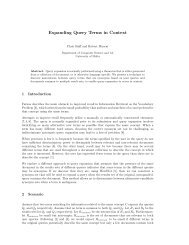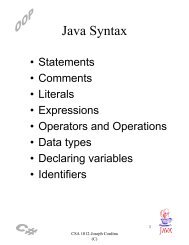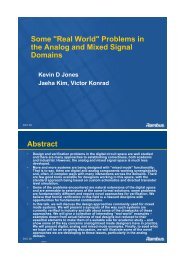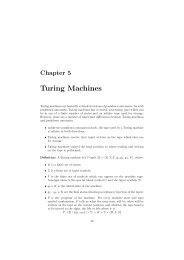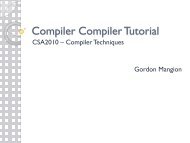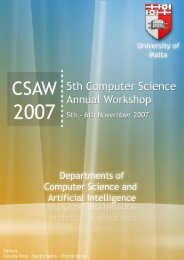Proceedings of CSAW'04 - FTP Directory Listing - University of Malta
Proceedings of CSAW'04 - FTP Directory Listing - University of Malta
Proceedings of CSAW'04 - FTP Directory Listing - University of Malta
You also want an ePaper? Increase the reach of your titles
YUMPU automatically turns print PDFs into web optimized ePapers that Google loves.
Low-Latency Message Passing Over Gigabit Ethernet Clusters 43<br />
Although commodity networks are still dominated by IP over Ethernet, these protocols were not<br />
intended for networks running at gigabit speeds due to several inefficiencies that will be discussed<br />
later. This led to the development <strong>of</strong> other interconnect architectures such as Myrinet [2], SCI<br />
[10], Giganet cLAN [7], Quadrics [15] and Infiniband [1] which were targeted towards achieving<br />
higher bandwidth reliable communication without incurring the processing overheads <strong>of</strong> slower<br />
protocols. Our work will be geared towards commodity platforms running over a Gigabit Ethernet<br />
architecture, since these are one <strong>of</strong> the most common and affordable cluster architectures available.<br />
2 High Performance Networking Issues<br />
Various performance issues arise when utilizing the standard Ethernet framework for gigabit communication<br />
within a cluster <strong>of</strong> commodity platforms. Although modern Ethernet hardware promises<br />
gigabit line-rates, this performance is hardly ever obtainable at the application layers. This is due<br />
to several overheads imposed by interrupt generation [8] as well as conventional layered communication<br />
protocols such as TCP/IP which although provide reliable messaging, also add significant<br />
protocol processing overheads to high bandwidth applications. First <strong>of</strong> all we will take a look at the<br />
steps involved in sending messages over a network using conventional NICs and generic protocols<br />
such as TCP/IP.<br />
2.1 Conventional Ethernet NICs<br />
Conventional network cards are cheap and usually characterised by little onboard memory and<br />
limited onboard intelligence which means that most <strong>of</strong> the protocol processing must be accomplished<br />
by the host. When the Ethernet controller onboard the NIC receives Ethernet frames, it<br />
verifies that the frames are valid (using CRC) and filters them (using the MAC destination address).<br />
When a valid network packet is accepted, the card generates a hardware interrupt to notify<br />
the host that a packet has been received. Since hardware interrupts are given a high priority, the<br />
host CPU suspends its current task and invokes the interrupt handling routine that will check the<br />
network layer protocol header (in our case being IP). After verifying that the packet is valid (using<br />
a checksum) it also checks whether that particular IP datagram is destined for this node or whether<br />
it should be routed using IP routing tables. Valid IP datagrams are stored in a buffer (IP queue)<br />
on host memory and any fragmented IP datagrams are reassembled in the buffer before calling<br />
the appropriate transport layer protocol functions (such as TCP/UDP). Passing IP datagrams to<br />
upper layer protocols is done by generating a s<strong>of</strong>tware interrupt and usually this is followed by<br />
copying data from the IP buffer to the TCP/UDP buffer.<br />
2.2 Problems with Conventional Protocols<br />
Since traditional operating systems implement TCP/IP at the kernel level, whenever an interrupt<br />
is generated the host would incur a vertical switch from the user to the kernel level in order to<br />
service the interrupt. This means that for each packet received the host would experience several<br />
switching overheads. Also due to the layered protocol approach, each packet would require several<br />
memory-to-memory buffer copies before it reaches the application layer. Both memory-to-memory<br />
copies as well as context switching (between kernel and user space) are expensive to the host<br />
CPU which means that the higher the rate <strong>of</strong> incoming packets, the more host processing power is<br />
required to service these packets.



